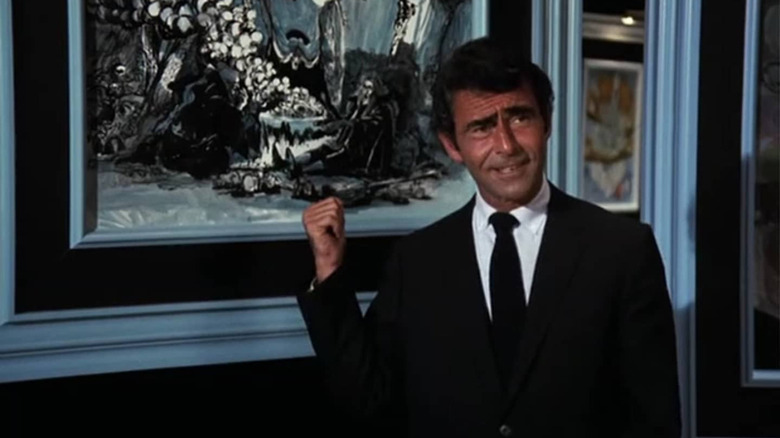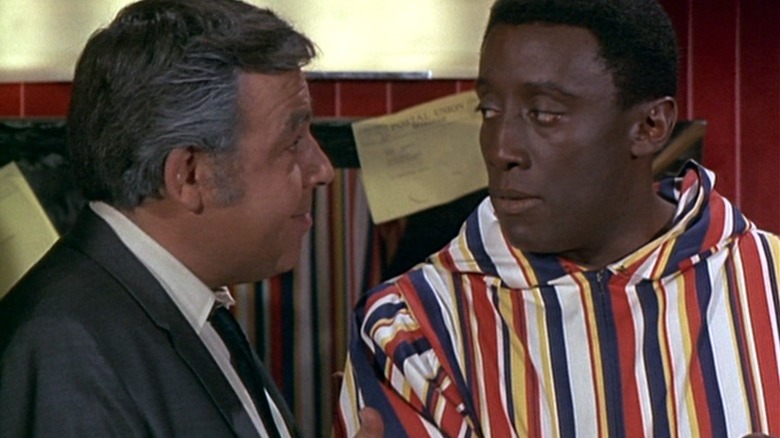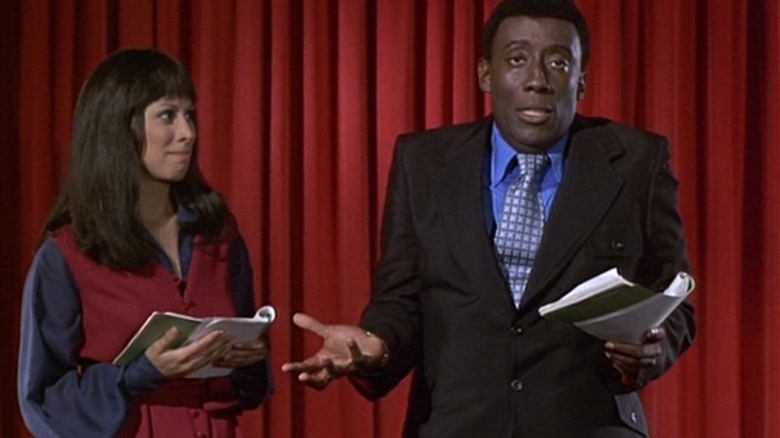Steven Spielberg's Night Gallery Short Appalled Executives So Much It Had To Be Reshot
Rod Serling's horror anthology series "Night Gallery," a spiritual follow-up to his hit show "The Twilight Zone," began its life as a 1969 TV movie, consisting of three separate episodes directed by Boris Sagal, Barry Shear, and an up-and-coming novice named Steven Spielberg. Sagal and Shear were a long-term TV veterans at the time, having worked on "The Twilight Zone" and "The Man from U.N.C.L.E." between them. "Night Gallery" was Spielberg's very first professional directing job. Spielberg's segment, called "Eyes," starred Joan Crawford as a wealthy blind woman who pays a huge amount of money for an experimental eyeball transplant that will give her perfect vision for a mere 11 hours. As she removes her bandages following the surgery, there is a blackout in her apartment. Cue the disappointed "Price is Right" trombone.
The "Night Gallery" TV movie was a success, and it led to a full-blown series in 1970. Serling introduced the series' supernatural segments by walking through an otherworldly art gallery, pointing to free-floating paintings, and explaining that each one was a representation of an ironic tale that was about to unfold. Because he did so well on "Eyes," the young Spielberg was asked to return to direct another segment for the TV show. This time, however, Spielberg was to become more ambitious, eager to flex his creative muscles. The segment in question was called "Make Me Laugh," and it was about a comedian who makes a deal with the Devil to be the funniest man alive. The twist is that he is laughed at, even when he is off stage, and he can never be taken seriously. Another sad trombone.
Spielberg thought he could film his segment in one, long, unbroken take. The "Night Gallery" producers hated that.
'Make Me Laugh'
As Steven Spielberg recounted in an interview with Stephen Colbert, he was able to block and shoot "Make Me Laugh" just the way he wanted. But, after putting in the hard work, the studio balked at the director's artiness, feeling that the young buck had inappropriately dispensed with the simple, proven style of TV directing. Spielberg recalled the thrill of making "Make Me Laugh" with actors Godfrey Cambridge, Tom Bosley, and Jackie Vernon, happy to delve into the fineries of filmmaking, and working with the limitations of 10-minute film reels (at the time, cameras could only hold 10-minute cartidges) even though his segment was meant to be 11 minutes in length. In his words:
"I came on the set, and because it was only 11 minutes long I had this idea of shooting the whole 11 minutes in one shot. [...] But I staged the whole thing across four sets in one shot. Storyboarded it, rehearsed it, everybody was excited about it, and then when the executives sat down to watch the rushes the next day they saw the entire 10-minute take of most of the show. And they were appalled."
They were appalled not by the subject matter, which was written by Rod Serling himself, but merely by Spielberg's style. It seems that, perhaps due to his youth and inexperience, Spielberg colored outside of the lines. In taking creative initiative, he stepped out of bounds. It is here that Spielberg might hear a sad trombone of his own.
Where's the coverage?
It's entirely possible Steven Spielberg, a longtime fan of John Ford, was thinking in broad cinematic terms, rather than practical 1970s TV terms. While directors were permitted to have a voice on anthology shows like "Night Gallery," the general wisdom seemed to be that there was still a "house aesthetic" at work. One can be creative, but only within certain bounds. Spielberg, still in his 20s at the time, hadn't picked up on that lesson, even after the "Night Gallery" TV movie. The studio, it seemed, needed close-ups. The director recalled the complaints, although he tactfully refused to name names:
"[They said] 'Where's the close-up coverage, where's the over-the-shoulder shots, where are the prerequisites for making it look like a television show?' And I immediately got a call from an executive, I won't mention that person's name, who said, 'We're appalled by what we see. That's one of the most irresponsible experiences I've ever had with a director working for me, and we're going to reshoot the show with another director.' And that was the end of it. I wish I had a copy of that shot. It was a terrific shot! But, I don't have a copy of it."
Spielberg is still the credited director on "Make Me Laugh," but it's unclear if someone else shot the episode as it aired.
The following year, in 1971, Spielberg would direct another TV movie called "Duel," his first feature-length project. The 74-minute broadcast was a massive success, and Universal decided they wanted to release the film theatrically overseas. Spielberg was hired to shoot additional footage, and a 90-minute version saw the big screen in less than a year. Spielberg was officially a film director.


